THE EAST LONDON MUSEUM
At the age of about 11 or 12 I started a mini-museum in the basement of our house in Nahoon. That fist one had sea shells, a wooden "needle" used to repair fishing nets and large rusty hook (they had been found during the excavations for the new Orient Pavilion), the handset of an old fashioned wind-up telephone (given to me by a friend of my granny) etc. We were to then move to Selborne with a dingy basement and the set up was not restarted, but the bug had bitten. I still have some of those items.
Our family had had close ties with the museum since its inception. My father served on the Board for many years. His father before him had been on the founding committee.
The following has been taken from the museum's own website which I quote in full and then elaborate on below :
A BRIEF HISTORY OF THE EAST LONDON MUSEUM
On July 19th 1921 a group of interested people met with the Mayor, Captain J. Neale, and Deputy Mayor, Dr James Bruce-Bays, to suggest the building of a Museum for East London in Selborne and to forma Museum Society. The first meetings of the Society were held in various member’s homes and then in rooms belonging to the premises of J. W. Jagger above the XL Tearooms, now XL Bazaars, in Oxford Street. The Society premises were known as East London Museum and the latter was recognized as an official Provincial museum in terms of proclamation 216 of November 28th 1924.
In 1926 the Museum moved to rooms at 9 Gladstone Street and in 1930 to 15 Gladstone Street, where they were to remain until, after much effort and fundraising, and a loan of 4000 pounds from the Provincial Council, the first purpose built building of the East London Museum next to the Technical College was completed. It was opened by Mr Voight, Acting Provincial Secretary on September 23rd 1931.
In the years after the Second World War the Museum collections outgrew the premises. The East London Technical College bought the 1931 building, and with a substantial grant from the Cape Province a new building was built in Oxford Street and opened on November 25th 1950 by the Administrator of the Cape, Mr. J. G. Carinus.
Significant additions were planned for the Museum to accommodate staff work areas and create exhibition space. By April 21st 1982 the foundation stone was laid by the Administrator of the Cape, the Honourable, Gene Louw, and on December 6th 1983 the new Museum Complex consisting of a foyer, administration and workshop area was opened by Mrs. Elsabe Kemp, M.P.C.
Building projects for the East London Museum were proposed from the late 1990’s, primarily to create viable storage facilities for collections. Following a successful application to the National Lottery Distribution Trust Fund for R2.6 million construction work on a two-storey storage repository and a new lecture hall commenced in March 2005. The new buildings were officially opened by the Chairman of the Board of Trustees, Mr. David Forsyth, on 22nd June 2006.
Christina Reeve
East London Museum
On that initial committee was my Great Grandfather Alexander Watson. ( WATSON, ALEXANDER RICHARDS ). My father was very proud of that and served on the Board for many years, including as chairman.
Our architectural practice was commissioned for the extension to the museum itself to create a grand new entrance with a small shop and lift, an office wing suitable for the many staff it had taken on, and a large new display space, since named the Latimer Wing. The office wing included workshops, a library and a cafe.
Designing the new entrance was interesting as we needed to have access directly from Oxford Street and simultaneously from the rear parking, both guiding visitors past the same control desk. This was achieved with a spiral staircase. That was somewhat stymied in later years with the increase in security issues and the whole premises being enclosed with a palisade fence. Access is now only from the rear.
The storage and workshop facilities at the rear of the building (that preceded our extension) have since been extended by others and now include a better lecture hall as noted above. Visiting the workshops was fascinating. I watched the taxidermists at work. The black guy was the more skilled even though the white overseer took the credit. (These were apartheid years). New techniques were being developed where animals were set in casts and their fur transferred almost intact into the eventual non-biological form which simply needed touching up.
When you read the Museum's websites today, you may gather that it is trying to downplay its coelacanth association in favour of a more up to date community significance and role. That coelacanth seemed to overwhelm so much of its identity for many years, but it must be accepted that it was a great boon to its prominence and funding.
East London Museum originally built its collection around natural history when it showed native plant specimens together with animal specimens and geological formations. Throughout its years of operation the museum developed by increasing its collection breadth to include archaeology and ethnography and local history material.
The historical site today provides visitors access to multiple displays and exhibitions. The museum showcases a complete range of prehistoric animal displays alongside compelling historical insights about the region’s colonial background thus providing an attraction for every visitor.......
The “Coelacanth” fish attracts worldwide attention as an extinct species which was discovered alive off East London in 1938. The East London coast yielded this ancient fish discovery in 1938 which now serves as a significant museum symbol.
Visitors can experience the “Our Story” show that reveals the profound cultural heritage of Xhosa people. People visiting the museum get to learn about the traditional ways and essential celebrations and vital developments that formed Xhosa society since ancient times. [Museum website].
Some of our family paraphenalia ended up in the museum stores. I hope that they survive the changing priorities and policies of successive administrations. On the other hand we have in our garden here in Scotland a large concrete owl. An artist had contributed relief sculptures in concrete to the facade of the 1950's building. Moulds for the owls still existed in the stores. When we were involved with the extension was also when we were building our house in Beacon Bay. I borrowed the moulds and cast several owls for that. One was a littel cracked and we set it in the garden. Then years later we managed to get it shipped out to Scotland along with our other belongings.
The new extensions
There has been some further work in recent years. What I discuss and record photographically below was that of 1982 comprising a new entrance block, an administration wing with a library and cafe as well as stores and the Latimer Wing for temporary exhibitions and events. Our practice was commissioned to design all this so I became closely involved too.
It was interesting to hear the museum staff discuss their visions of what the museum should be. Perceptions in fact varied quite a bit. Besides my ties with the museum through the family, I had done a university thesis on a hands-on museum known oversees as an Exploratorium. While that was not the direction this one took, it gave me fresh insight to the workings of a museum and its operational policies. I was pleased to note that after apartheid fell, it became much more community focussed and representative.
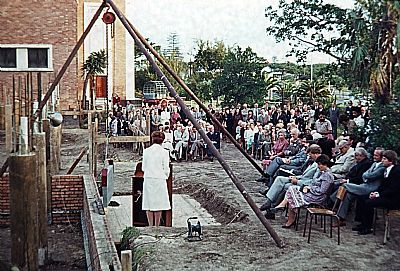
This was the moment that Mrs. Elsabe Kemp gave the opening speach. She had been a mayor and was by this time a Member of the Provincial Council. The foundations stone was laid by.the Administrator of the Cape, the Honourable, Gene Louw on December 6th 1983. The works included a foyer, administration and workshop area. I took this photo from the side. My mother in a reddish dress and my father sit near the leg of the hoist for the stone.
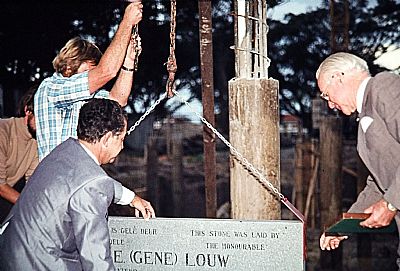
It appears as if the Administrator has been roped in to help build the extension. Here he is ensuring the stone is level and plumb, assisted by the foreman to the left and the chairman of the board / architect, my father to the right.
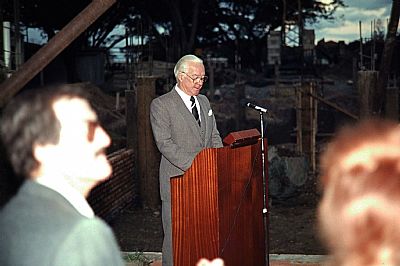
The chairman of the board gets to make a speach too. To the left is the director Eric Bigalke and to the right, Elsabe Kemp.
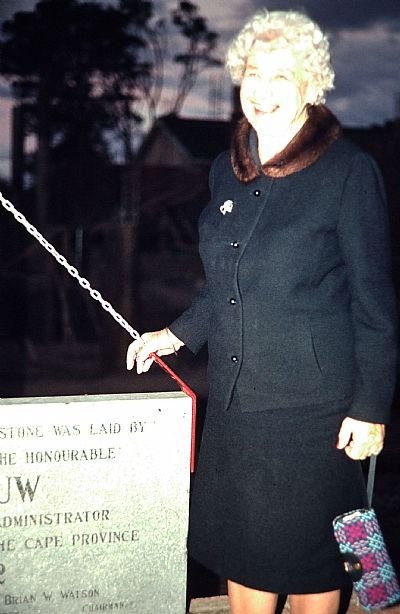
The past director, Marge Courtney-Latimer.


Two pictures of the junction between new and old.
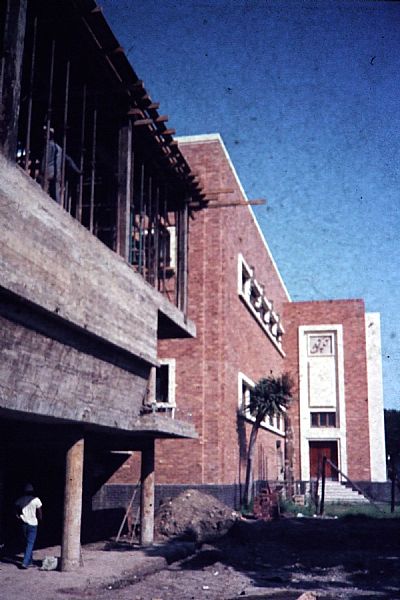
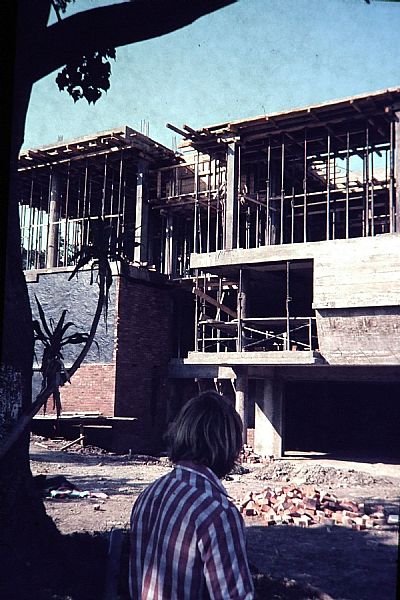
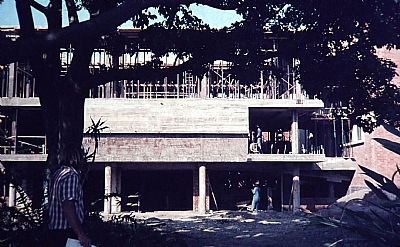
Some views of the new frontage.

The rear entrance taking form. The administration block is to the left.


Trusses afjacent the older side facade.

The multi-level atrium showing the forming the form that forms the angled shape over the entrance.

And the resultant galleries linking the new and old.
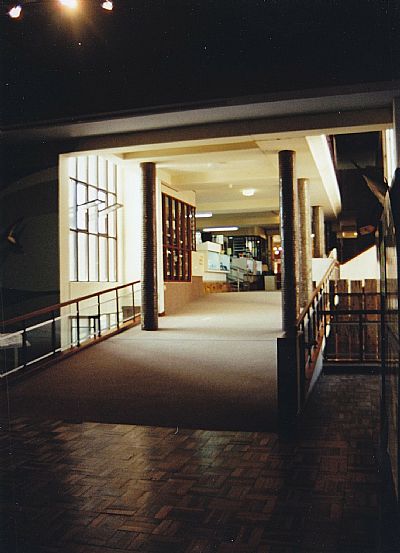
Reception level

Looking towards the small shop to the left. The Latimer Wing is in the background.
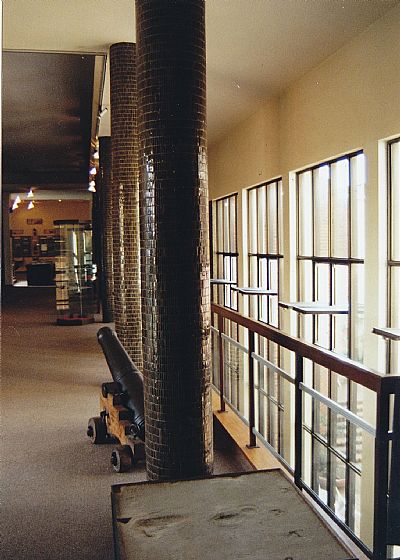
The level with the ship's cannon and prehistoric footprints from Nahoon.

The main entrance off Oxford Street.

A similar view, but this one shows more of the plainer facade of the Latimer Wing. Note the two owls. We found the moulds of these, as produced for the older section, still intact and usable. They were almost a 3D puzzle to put together. Sections for the areas with deeper had separate pieces. A release agent (old engine oil) was spread across the mould and we got several cast. [I borrowed these moulds and cast some for our new house that we were building in Beacon Bay. We managed to get one of those all the way to our garden in Scotland when we emmigrated].

The main entrance with a wagon.

A sun & shade dappled main entrance.
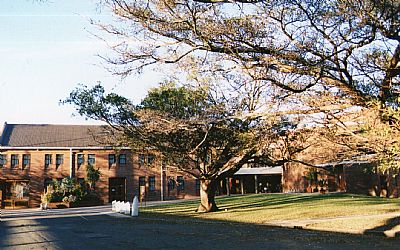
The rear approach looking towards the administration block.

The rear entrance alongside the administration block.

The Latimer Wing has large expanses of walls so I expressed the structure by presenting the colums outwards. This also creates alcoves within the large internal space which are handy for most temporary displays.
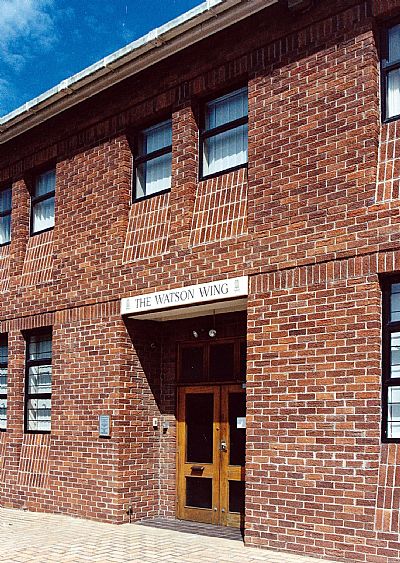
I was able to introduce brickwork features on the administration block too. Such detailing would be almost impossible in Scotland due to the complexity of thermal bridging concerns; insulation and isolation being very different in such different climates.
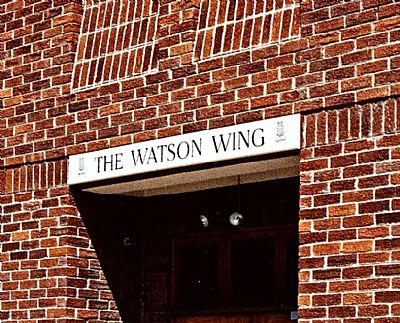
This is an extract from the previous photo. The administration section was name "THE WATSON WING" in recognition of my father's contribution to the museum board over many years and to his father before him being one of the founding figures of the museum.
The earlier museum building that had been absorbed into the Technical College was where I was sent as a young child for elocution lessons. Our elder daughter also used it for some of her ballet classes.
EAST LONDON MUSEUM : https://elmuseum.za.org/About-Us/index.php/ and https://beoriginaltours.com/the-fascinating-history-of-east-london-museum/

